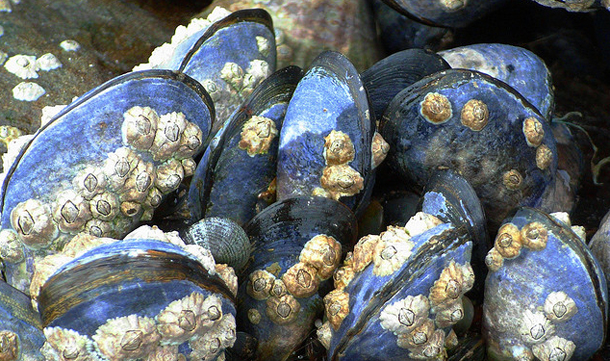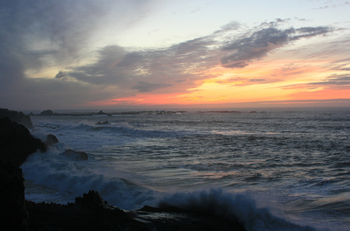Caffeine in Ocean Water
Air Date: Week of August 10, 2012
 |
Researchers are finding caffeine in the ocean and streams of the Pacific Northwest. Portland State University Professor Elise Granek tells host Steve Curwood that scientists are concerned that caffeine can stress aquatic organisms and may be an indicator of additional pollutants in the water.
Transcript
CURWOOD: For coffee drinkers, the Pacific Northwest is holy ground. It's where companies like Seattle's Best Coffee and Starbucks got their start. But researchers recently discovered some surprising information in the land of coffee: caffeine in the ocean, lakes and rivers. And the likely source is the toilet.
Elise Granek is an assistant professor of environmental science at Portland State University in Oregon and is co-author of the new report finding caffeine in waters of the Pacific Northwest.
Professor Granek, welcome to Living on Earth.
GRANEK: Thank you for having me.

More research needs to be done to see what effect caffeine might have on fish. (Photo by Fiona Henderson)
CURWOOD: So how does caffeine get into the water?
GRANEK: Well, in the temperate zone in the northwest where we live, there is no known natural sources of caffeine. So, when we see caffeine in rivers or lakes or the ocean, our understanding is that the source is human waste. And that human waste may be from coffee, it may be from energy drinks, from pharmaceuticals, etc.
CURWOOD: Now, where exactly did you find this caffeine...in the ocean, in freshwater?
GRANEK: Our findings were actually quite surprising. Our design was set up to look at high pollution threat areas and low pollution threat areas, and our high pollution threat areas were areas of the Oregon coast with the highest human population densities where there was a wastewater treatment plant in the vicinity and there was a river flowing into that ocean area.

The Oregon coast. (Photo: Daniel Powell)
Low pollution threat areas were sites far from population centers with no wastewater treatment plant for at least five miles and no river flowing into the ocean for at least a mile. And, surprisingly, our highest levels were at our low pollution threat areas, much to our surprise.
CURWOOD: Why do you suppose that is?
GRANEK: So, in high human population density areas, there's wastewater treatment plants that are treating human waste. Although wastewater treatment plants in the U.S. are reported to only have about a 60-70 percent efficiency rate at removing caffeine, that's probably enough to remove most of the caffeine and the remainder is diluted out.
Whereas at sites where there's low human population densities, those communities are usually not on a centralized wastewater treatment plant. So, instead, each household or business has its own on-site disposal system, and on-site disposal systems have fewer regulations and monitoring requirements. When we're talking about on-site disposal systems, most of those systems are septic tanks.
CURWOOD: Now, why are you studying this? I mean, you're not concerned that the fish are having trouble sleeping, are you?
GRANEK: No, we actually haven't looked at the effects on fish. We've done some research looking at the effects on inter-tidal mussels.
CURWOOD: And the results there?
GRANEK: In terms of a general understanding of amounts, it's a very small amount. What we found, the maximum we found in the ocean was 45 nanograms per liter. And the maximum we found in an adjacent river was just over 150 nanograms per liter. So we're talking about a very small amount.
However, in our lab study on effects of caffeine, 50 nanograms was the lowest dose we looked at in terms of effects on mussels. And, that was enough of a dose to cause mussels to generate stress proteins. There have been some reports that caffeine may affect reproduction. When organisms are stressed, they produce stress proteins to protect their cells. And, if an organism is under prolonged stress, then that organism may have to shift energy they would normally spend on growth and reproduction, on continuously making those stress proteins. So, that's one piece of it.

Elise Granek’s team found evidence of caffeine in mussels they tested near the Oregon coast. (Photo: John Ash)
The other piece is that caffeine may be a marker, is likely a marker of other contaminants that accompany it in wastewater. So when we see caffeine, we expect it to be an indicator of wastewater, and in wastewater we have not only caffeine, but pharmaceuticals, we have household cleaners, we have a suite of contaminants which have the potential to impact these marine organisms, as well.
CURWOOD: So, how much of a human health risk is all of this caffeine in the water?
GRANEK: You know, some chemicals bioaccumulate in tissues. We don't expect that caffeine bioaccumulates in tissues but, again, it may be an indicator of other contaminants and other chemicals that are able to bioaccumulate in tissues. And so, people that are eating intertidal mussels, for example, if there's high levels of caffeine at those sites, we are interested in finding out what other contaminants may be accompanying that caffeine at those sites, and whether any of them are contaminants of concern for human health.
CURWOOD: Now, your research is based in the Pacific Northwest but I understand that researchers have found caffeine in water all over the country, including my backyard of Boston Harbor.
GRANEK: Correct, yes.
CURWOOD: And so how prevalent is this?
GRANEK: At least in the U.S., there are published numbers for Kauai in Hawaii, for Miami River and Biscayne Bay in Florida, for Boston Harbor, Sarasota Bay, Florida, and Jamaica Bay, New York and at least one site in Canada.
CURWOOD: So, Professor Granek, what needs to be done next?
GRANEK: I think, first of all, we need to identify the sources. Once we identify the sources of these contaminants, if they are indeed on-site septic systems, our ultimate goal is to provide information that will inform management and policymaking to reduce the level of contaminants that are entering marine systems.
CURWOOD: Elise Granek is assistant professor of environmental science at Portland State in Oregon. Thank you so much for taking this time.
GRANEK: Thank you. Thanks for having me.
Living on Earth wants to hear from you!
Living on Earth
62 Calef Highway, Suite 212
Lee, NH 03861
Telephone: 617-287-4121
E-mail: comments@loe.org
Newsletter [Click here]
Donate to Living on Earth!
Living on Earth is an independent media program and relies entirely on contributions from listeners and institutions supporting public service. Please donate now to preserve an independent environmental voice.
NewsletterLiving on Earth offers a weekly delivery of the show's rundown to your mailbox. Sign up for our newsletter today!
 Sailors For The Sea: Be the change you want to sea.
Sailors For The Sea: Be the change you want to sea.
 The Grantham Foundation for the Protection of the Environment: Committed to protecting and improving the health of the global environment.
The Grantham Foundation for the Protection of the Environment: Committed to protecting and improving the health of the global environment.
 Contribute to Living on Earth and receive, as our gift to you, an archival print of one of Mark Seth Lender's extraordinary wildlife photographs. Follow the link to see Mark's current collection of photographs.
Contribute to Living on Earth and receive, as our gift to you, an archival print of one of Mark Seth Lender's extraordinary wildlife photographs. Follow the link to see Mark's current collection of photographs.
 Buy a signed copy of Mark Seth Lender's book Smeagull the Seagull & support Living on Earth
Buy a signed copy of Mark Seth Lender's book Smeagull the Seagull & support Living on Earth

